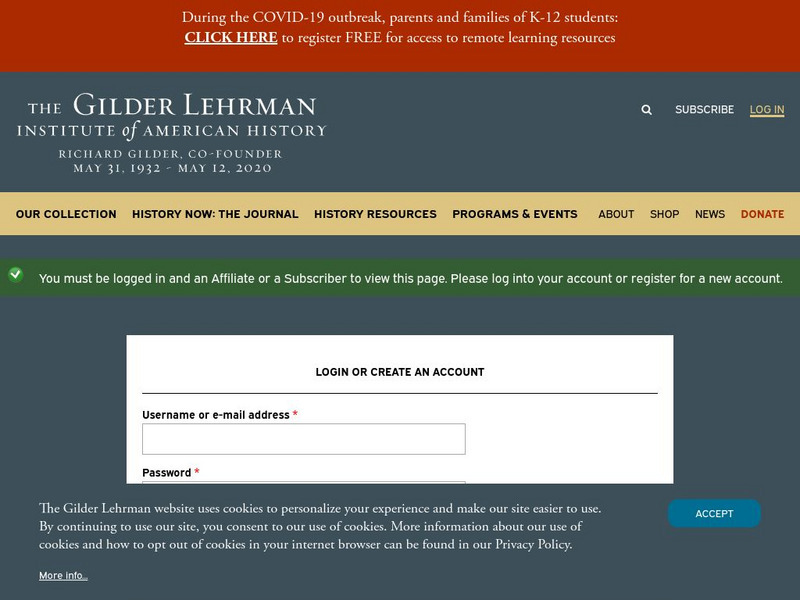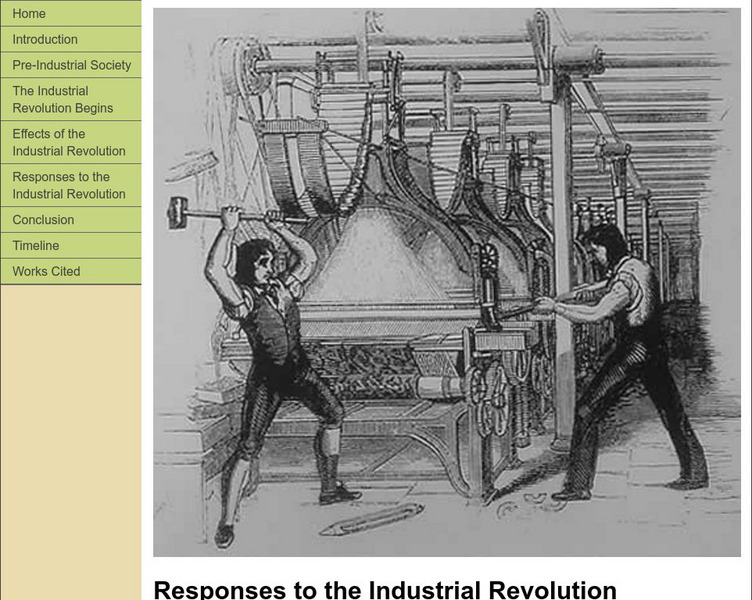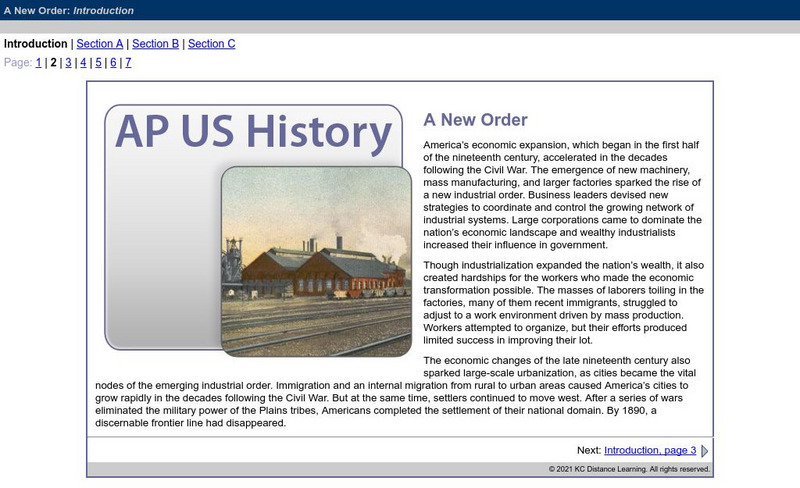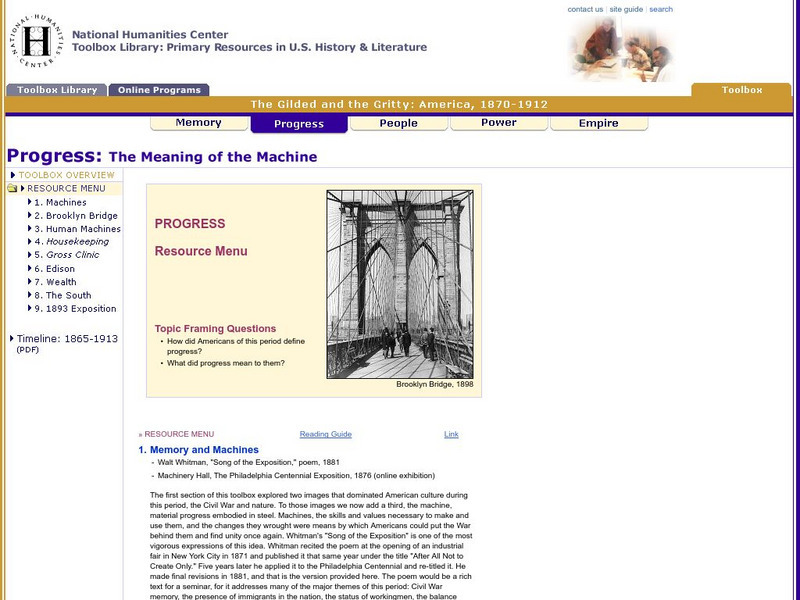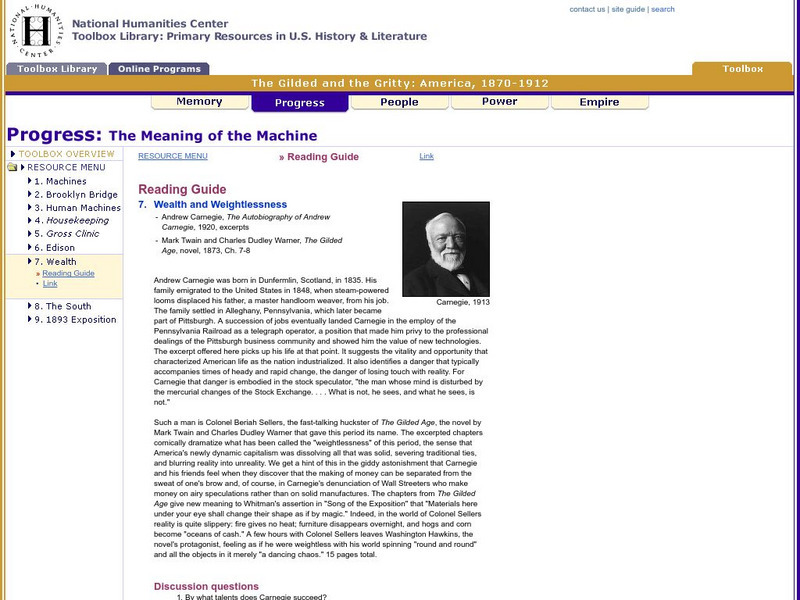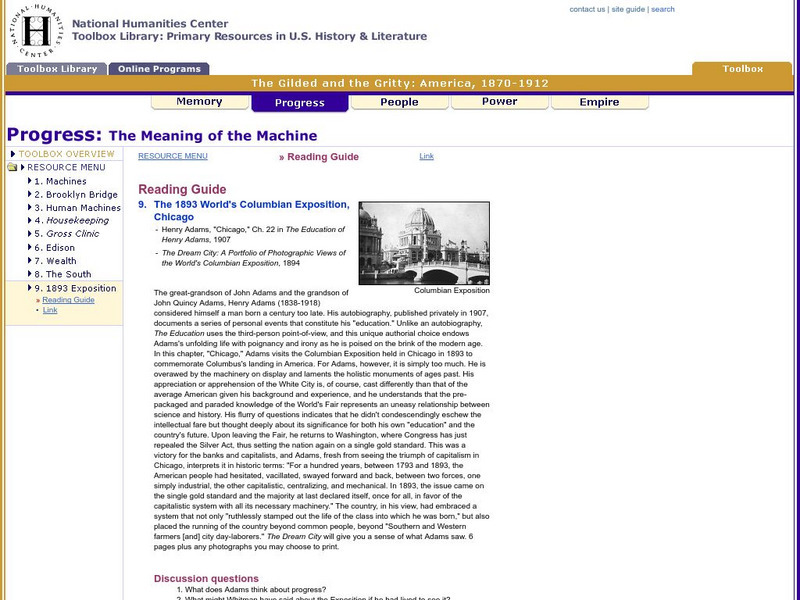Library of Congress
Loc: Teachers: Child Labor in America
Historical photographs provide learners with a firsthand look at the issue of child labor during the late-nineteenth and early-twentieth centuries. In this lesson, students will use photographs to further understanding of the politics,...
Other
Middle Tennessee State University: The Progressive Movement: Life as a Muckraker
In this lesson plan, young scholars learn about the muckraking journalists who exposed social injustices during the Progressive Era and what the Progressives believed. They will examine primary sources, including the works of prominent...
Gilder Lehrman Institute of American History
Gilder Lehrman Institute: Immigration and Migration
[Free Registration/Login Required] A lengthy essay discussing the differing opinions about immigration and the role of immigrants in the United States in the latter half of the 19th century and the early 20th century. Find out about the...
Virginia Historical Society
Virginia Museum of History and Culture: Teaching With Photographs
"Teaching with Photographs" includes images from the Virginia Historical Society's collection. The images are organized into several themes which allows this source to be used by younger and older grades. Resources for teachers are...
Other
Federal Reserve Bank of Boston: The Economics of Pro Team Sports
Great interactive baseball game that combines your knowledge of economics and pro sports trivia. After completing the nine innings, you should have a better understanding of how economics is used in everyday life.
Other
Modern World History: Responses to the Industrial Revolution
This section of the text looks at how workers, owners, and the government responded differently to the negative effects of the Industrial Revolution. The Luddites rebelled against industrialization. Robert Owen, a wealthy socialist,...
Other
Modern World History: Effects of the Industrial Revolution
In this textbook unit, students learn about working and living conditions during the Industrial Revolution, the growth of cities, public health issues that emerged, child labor, the impact of factory work on families and on women, the...
Blackdog Media
Classic Reader: The Jungle by Upton Sinclair
Classic Reader provides numerous classic works from famous authors. First published as a serial in the Appeal to Reason 1905, one work is The Jungle, by Upton Sinclair. It exposed harsh working conditions in the meat packing industry.
ibiblio
Ibiblio: Collectivization and Industrialization
Excellent site that is part of a larger collection of documents from the Soviet System. Site gives a good explanation of the Five-Year plans put into effect by Stalin.
CK-12 Foundation
Ck 12: World History Episd
Flexbooks 2.0 are interactive, customizable, digital textbooks. Flexbooks are standards-aligned. Flexi, a student tutor, is integrated into each book to guide you on your learning journey. Flexi can assist in learning, answer questions,...
British Library
British Library: Bronte's Wuthering Heights: Fantasy and Realism
Students will consider the two elements of fantasy and realism that combine to create the compelling narrative in Wuthering Heights (1847). In this activity, students will explore the significance of nature within the narrative, its...
National Women’s History Museum
National Women's History Museum: The Triangle Shirtwaist Fire
Student will use primary and secondary sources to gain a richer understanding of women's activism and how the Triangle Shirtwaist Fire led to changes in labor and safety regulations in America.
Department of Defense
Do Dea: Ap Us History: Unit 5: A New Order
This extensive learning module examines the impact of the Gilded Age upon new cultural and intellectual movements, expansion of foreign trade, and political debates over economic and social policies, as well as the impact of the rise of...
Khan Academy
Khan Academy: Ap Us History Unit: Period 7: 1890 1945: The Progressive Era
The study resource from Khan Academy provides an overview of Period 7: 1890-1945: The Progressive Era. An overview of an Progressive Era is provided. This resource is designed as a review for the AP US History Test.
National Humanities Center
National Humanities Center: Toolbox Library: The West, the Gilded and the Gritty: America, 1870 1912
Four nineteenth-century landscape paintings that suggest the meaning of the West in American life.
National Humanities Center
National Humanities Center: Toolbox Library: Associations (I), Making of African American Identity: V. 2
Newspaper articles that illustrate how benevolent and charitable societies fostered racial solidarity among African Americans in late-nineteenth-century America are provided. Links to these articles can be found on the second page.
National Humanities Center
National Humanities Center: Toolbox Library: Railroad, the Gilded and the Gritty: America, 1870 1912
A speech and an engraving that illustrate how the railroad helped to unite the country after the Civil War.
National Humanities Center
National Humanities Center: Toolbox Library: Progress, the Gilded and the Gritty: America, 1870 1912
Eighteen primary sources-historical documents, literary texts, and visual images-that explore the industrial, racial, and technological progress of the late-nineteenth century.
National Humanities Center
National Humanities Center: Toolbox Library: Progress: The Meaning of the Machine: Memory and Machines
A poem by Walt Whitman, "Song of the Exhibition," and the on-line catalog of the 1876 Philadelphia Exposition that celebrate the growth, power, and expansion of the nation.
National Humanities Center
National Humanities Center: Toolbox Library: Gross Clinic, the Gilded and the Gritty: America, 1870 1912
Thomas Eakins's controversial painting that reflects the skill of professional, scientific practitioners during the late-nineteenth century.
National Humanities Center
National Humanities Center: Toolbox Library: Wealth, the Gilded and the Gritty: America, 1870 1912
An excerpt from Andrew Carnegie's autobiography that describes his attitude toward wealth and an excerpt from the novel The Gilded Age by Mark Twain and Charles Dudley Warner that suggests the giddy, unreality of an America caught up in...
National Humanities Center
National Humanities Center: Toolbox Library: Progress: The Meaning of the Machine: Southern Stasis
A survey of the lagging Southern economy of the late-nineteenth century and two speeches, one by a black Southerner and one by a white Southerner, making the case for Northern investment in the region.
National Humanities Center
National Humanities Center: Toolbox Library: The Meaning of the Machine: The 1893 World's Columbian Exposition
Two views of late-nineteenth-century American progress: Henry Adams criticizes it in his autobiography, and the Columbian Exposition of 1893 praises it.
National Humanities Center
National Humanities Center: Toolbox Library: Pullman Strike, the Gilded and the Gritty: America, 1870 1912
An article that describes the Utopian factory town George Pullman built for his workers, a statement of the grievances that led them to strike against the company, the Pullman Company's response, and an editorial speculating on the...




